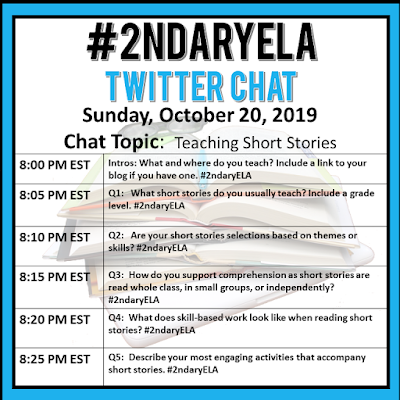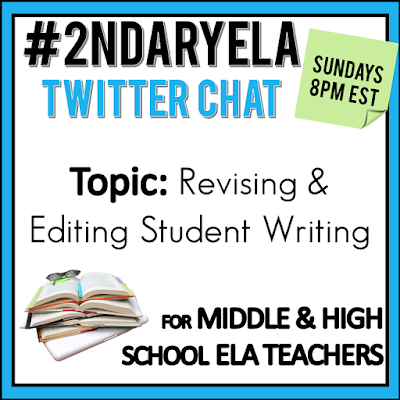This year I am pushing my students to write and rewrite, to look at their word choice and choose stronger verbs and more specific nouns, to add sensory details. This Halloween will be no different.
I like to do a writing activity on Halloween because although I teach sixth grade, I think older kids should get to enjoy some holiday fun just like the little ones. Last year I had my students write two sentence horror stories and I'll be doing it again this year. To set the mood, I picked out some spooky music from YouTube. There's a ton of choices out there, but this year I have a bunch of Harry Potter fans so I may use this playlist from the films.
I start out introducing two sentence scary stories by showing students just a few examples. I show them one that uses dialogue, one that is fairly short, and one that has more description. I don't like to show them too many because then they'll struggle to come up with their own ideas. For that same reason, the examples I show are not the the spookiest either. If you are looking for more examples, there's some spine tingling ones here.
After looking at examples, students brainstorm a plot for their two sentence story, responding to a series of questions covering the who, what, when, where, and why? Then students write a first draft.
Next up is peer revisions. Students swap papers with a peer who identifies places to add sensory details, possibilities for stronger verbs, and nouns that could be more specific. After getting a peer's feedback, students write a second draft which must be approved by me before they can write out and decorate a final copy. I put in this approval step mostly to just make sure nothing inappropriate is written, but mostly last year I had to keep telling students their story wasn't actually spooky.
If you'd like to use this lesson, you can find the instructions here and the handout here. Happy writing!
I like to do a writing activity on Halloween because although I teach sixth grade, I think older kids should get to enjoy some holiday fun just like the little ones. Last year I had my students write two sentence horror stories and I'll be doing it again this year. To set the mood, I picked out some spooky music from YouTube. There's a ton of choices out there, but this year I have a bunch of Harry Potter fans so I may use this playlist from the films.
I start out introducing two sentence scary stories by showing students just a few examples. I show them one that uses dialogue, one that is fairly short, and one that has more description. I don't like to show them too many because then they'll struggle to come up with their own ideas. For that same reason, the examples I show are not the the spookiest either. If you are looking for more examples, there's some spine tingling ones here.
After looking at examples, students brainstorm a plot for their two sentence story, responding to a series of questions covering the who, what, when, where, and why? Then students write a first draft.
Next up is peer revisions. Students swap papers with a peer who identifies places to add sensory details, possibilities for stronger verbs, and nouns that could be more specific. After getting a peer's feedback, students write a second draft which must be approved by me before they can write out and decorate a final copy. I put in this approval step mostly to just make sure nothing inappropriate is written, but mostly last year I had to keep telling students their story wasn't actually spooky.
If you'd like to use this lesson, you can find the instructions here and the handout here. Happy writing!

































